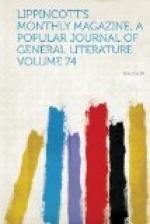Our next halt was at Niobrara Creek, called also L’eau qui court and Running Water, These three names (all with the same meaning) are far prettier than the place. Not a stick of timber, not a shrub, can be seen upon its banks. There was a flowing stream, a wide meadow, full of what looked like pink clover, but was only a bitter weed, and behind and before us the desert, in which our lively little camp was the only life to be seen. We soon found that we were not beyond the power of the spirits of Rawhide Peak. “O’er the far blue mountain” came the whirlwind punctually at dinner-time, but, fortunately, we had been somewhat beforehand with it, and had already stowed away our soup safely. The dust could not get at the champagne which we drank in honor of a wedding anniversary. Lighting our camp-fire, we forgot all else in listening to stories of the war and its heroic life; of Indian scares and massacres; of handfuls of men defending themselves behind their dead horses and driving back the foe; of brave young fellows lying cold and mutilated upon the Plains; of freezing storms of snow and hail; and of the many hair-breadth ’scapes and perils of the wilderness, till we all became Desdemonas of the hour. We felt that though we were probably as safe as ever in our lives, yet there were possibilities that gave our position just enough spice of danger to be exciting.
Looking out during the night, I saw a misshapen gibbous moon, of a strange green-cheese color, setting between the four legs of a mule, whose body made an arched frame for it. The effect was most grotesque. A ride on horseback next morning over the fresh breezy divide was a charming change from the monotonous ’bus. How the larks sang for us on that bright morning! and coyotes and blackbirds with white wings fled away before us. A little after noon we struck the sources of the White River, pleasant springs on a hillside, bubbling forth among the first trees we had seen since we left the Laramie. Then we descended into a fine shady valley: all our old friends were there in thickets—the box-elder, willow, birch and cottonwood, the alder, osier and wild cherry, currant, gooseberry, buffalo-berry and clematis. As we went on, brushing through the thick foliage, the hills on either side became higher, and grew into bastions, castles, donjon-keeps and fantastic clustered chimneys, like Scott’s description of the valley of St. John. The river went circling about through the intervale, so that we had to cross it constantly upon the little bridges made during the White River expedition in the February before. It was pleasant thus to wind along under the overarching boughs, coming frequently upon some pretty reach of the stream, where we could watch the cavalcade crossing, dashing out from under the bushes or watering the horses, while the heavy white-topped wagons plunged into the water and slowly mounted the opposite bank. In the distance the men were scouring the hillsides for deer, and perhaps looking out a little for Indians also. We went on in military order, with mounted pickets in advance, in the rear and on both sides; not that there was any danger, but an Indian is an inscrutable mystery, a wolf on two legs, and it is not easy to know what he may do.




